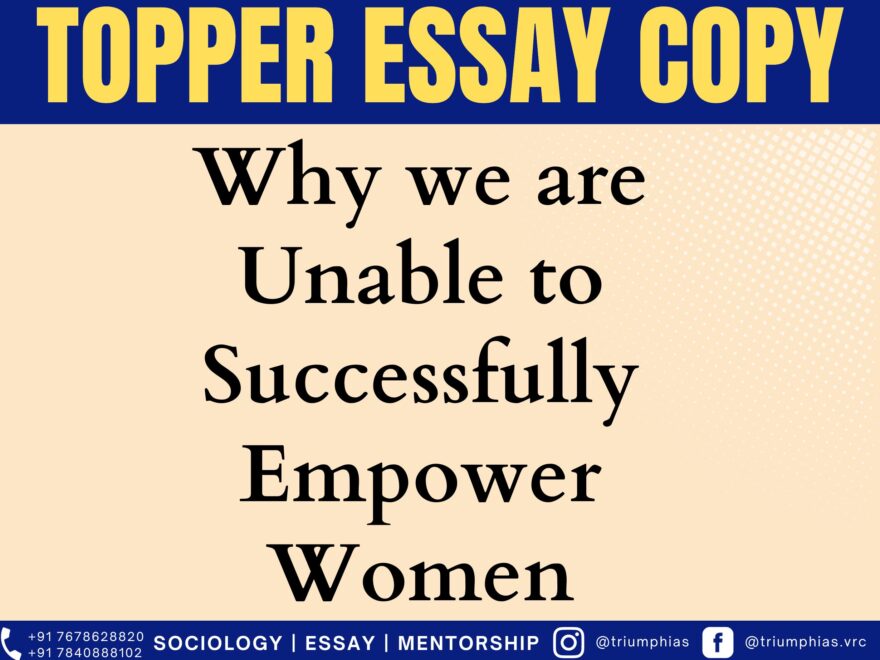Adarsh Kant Shukla

Essay Topic:
Why we Unable to Successfully Empower Women
(Relevant for Essay Writing for UPSC Civil Services Examination)
Why we Unable to Successfully Empower Women“They choked her passion, They crushed her dreams, She stood there still, she can’t even scream, Give her wings this time let her fly, Let her explore, the limitless sky.” Women empowerment has been a discourse on the global for a since a long time. There have been several successful efforts to enable women to realize their potential. However, despite the efforts, the progress on ground demonstrates that women empowerment is yet to take place in spirit. In some cases, we have given her wings, but cluttered ones, while in other cases, the wings are fine, but we’ve limited her sky through socio-economic barriers. We shall now explore the reasons behind the same. Women empowerment: A visit to our past:-Cotton often used to say, “when men are oppressed, it’s a tragedy, but when women are oppressed, it’s tradition.” When we look back at our traditions, we somehow resonate with Letty in certain aspects. Women have been accorded secondary status in various cultures. For example – In Christianity, women are assumed to be derived from the “rib of man”, Similarly in Islam, women oppression is legitimized through sharia codes. However, we also have shining examples of traditional women breaking the glass ceiling and establishing their mark. In Vedic age, women like Gargi, Maitri, were prominent intellectuals of their society. Similarly, religions like Quakerism and Sikhism have been egalitarian in their scriptures when it comes to women. Even in Islam, we have examples of strong and empowered lady figures like Razia Begum and Noor Jahan. Women empowerment: An incomplete project:-In the social sphere, the limits of women empowerment are most accentuated and consequential. A case study by Harsh Mander, a social activist, talks about the prevalence of purdah and the stigma of widowhood being entrenched in several rural areas of West India. Despite the existence of legislations like the Special Marriage Act, women are often prone to honor killings if they choose their partner. Caste and patriarchy often go hand in hand to yield detrimental consequences for women, in the form of Dalit patriarchy feeding violence, and Brahminical norms feeding sanctions. In the political sphere, women are subjected to objectification in election rallies. Even under the premises of parliament, women have to endure humiliating comments which toxic masculinity has to offer. According to the Association for Democratic Reforms, women participation in parliament has increased to 16% now, but they have been deprived of any substantial role or gender-based legislation to begin with. In terms of employment, women suffer from the problem of the “leaky pipeline” and “glass ceiling”, with the majority stuck in pink-collar jobs i.e., cleaning, catering, and caring. Even though the service sector has strengthened women participation in the economy, the presence of women at the topmost executive posts still remains less than 15%. In rural areas, male migration leads to the feminization of agriculture causing agri distress as women often are not entitled to ownership rights of land. Every second woman in India is prone to Anemia (NHFS-4). With changing lifestyles, reproductive issues are also increasing. This is further worsened by limited access to education and skilling opportunities. The process is complicated by novel realities like climate change which is causing problems like polygamy and water-wives, ending up exploiting women more. Women empowerment: The missing pieces in the puzzleThe reasons behind the grim picture are manifold, differing from sector to sector. In the social sphere, the main problem is cultural lag. As the liberal feminists say, “Our institutional strides have improved, but our majority’s attitude hasn’t.” When attitudinal indifference is met with women-centric reforms, phenomena like “panchayat pati” emerge, where empowerment is only tokenistic. Apart from behavioral change, we face another issue i.e., punitive paternalism. It refers to the usage of legal or institutional instruments to correct a social evil, which often proves counter-productive in the absence of behavioral change. For example, the Hindu Succession Act was brought to enable daughters to inherit their parental property equally with sons. However, it led to an increase in female feticide in North India. Similarly, the enactment of POSH amidst the “me too” movement and the Prevention of Sexual Harassment Act at workplaces led to skepticism among recruiters towards employing female employees. In the political sphere, empowerment is constrained by the rampant criminalization of politics. According to ADR, the nexus between money and muscle is something which women candidates often fail to surpass. On top of this, gender-colored remarks in rallies and cyberbullying through social media trolls are also worrisome. Since women are often not privileged enough to have plentiful resources at their disposal, lesser election expenditure on publicity and organizing forums and speeches often puts them at a disadvantage. Another reason behind our limitation is that our laws often fail to address the issues behind the closed doors in a woman’s life. As Indira Jaisingh, a famous supreme court lawyer argues, Indian legislatures have often been conservative when it comes to making reformative laws concerning private patriarchy. We can cite the example of resistance which B.R. Ambedkar had to face due to a clause in the Hindu marriage code which allowed a girl to marry a man of her choice. The top-down approach and ritualism in implementation have been another barrier in women empowerment. When empowerment initiatives like Nirbhaya funds remain underutilized and Sakhi One-Stop centers lack maintenance, empowerment is endangered. With abysmal access to technical education for women in rural hinterlands, we ourselves have reduced the efficiency of the most powerful weapon of social mobility – education, in women empowerment. Indian society’s Devi dichotomy has been a driver of patriarchy, i.e., on one hand, deification of females takes place in households and temples, on the other, increasing violence and sanctions harm their participation in the mainstream. Amartya Sen says that India has already underutilized its potential due to 20 crore “missing women” due to reasons like female infanticide, feticide, and dowry deaths. Women empowerment: Undoing the blunders:-Mother Teresa often used to say, “Yesterday is gone. Tomorrow has not yet come. We have only today, let us begin.” Thus, we need to begin today itself. The primary requisite for empowering women is the formation of human capital. The provision of gender-inclusive cells in the new education policy is commendable in this regard. In the political realm, we can learn from Odisha where women have been mobilized in SHGs like Swayamsiddha. With a separate Department of Shakti for women SHGs, Odisha has also provided for a 33% reservation for women in the assembly, which indicates the need to pass the women reservation bill in Parliament too. For harnessing the employment scenario for women empowerment, we need a drive like Japan i.e., WOMENOMICS – Incentivize employers to recruit females, provide stipends to female researchers, promote gender-based grant funding in institutes for capacity building. To address the culture gap, leverage the power of social media and civil societies to spread messages like “#selfie with daughter” in the common conscience. At the same time, create CYBER-Sakhis to monitor cyberbullying against women. WOMEN EMPOWERMENT: RE-ENVISIONING THE FUTUREHuman rights activist, Irshad Manji, once said, “We must simultaneously honor the positive traditions of all communities, but challenge them to live up to the standards of justice. Thus, we need a paradigm shift, which is beyond women empowerment, but towards gender justice. Gender justice entails equal access to resources, equal opportunity to participate in the economic, social, political spheres and equal treatment in private and public spaces. In this, the role of both men and women is significant as it entails collective responsibility and collective welfare. Only through gender justice can we truly embody the essence of Vasudhaiva Kutumbakam. The question is not whether a woman can do anything which a man can, but whether she can be allowed to do so. Thus, let us, through our combined efforts, let the woman decide and define her path.” |
To master these intricacies and fare well in the Sociology Optional Syllabus, aspiring sociologists might benefit from guidance by the Best Sociology Optional Teacher and participation in the Best Sociology Optional Coaching. These avenues provide comprehensive assistance, ensuring a solid understanding of sociology’s diverse methodologies and techniques
Meta Tags:
Urbanisation, Blessing, Disguise, Economic Growth, Cultural Diversity, Environmental Challenges, India, Social Inclusion, Sustainable Development, SDG Goals, Urbanization is a blessing in disguise, Laxman Tiwari, Laxman Tiwari upsc, Laxman Tiwari CSE, Laxman Tiwari Essay copy, Laxman Tiwari Essay test copy

Why Vikash Ranjan’s foundation Classes for Essay?
Proper guidance and assistance are required to learn the skill of writing essay topics in CSE examination. VIKASH RANJAN SIR at TRIUMPH IAS guides students according to the Recent Trends of UPSC, making him the Best Essay Teacher for Essay writing UPSC.
At Triumph IAS, the Best Essay Writing Coaching platform, we not only provide the best study material and applied classes of Essay for IAS but also conduct regular assignments and class tests to assess candidates’ writing skills and understanding of the subject.
Choose The Best Essay Writing Teacher for IAS Preparation and Know our Approach for Essay?
- The Programme is Planned & Executed in a Way that You Write a good Essay for obtaining Effective Score of 140 Plus.
- In this programme we provide Classes on
- How to INTRODUCE The Topic in Context of the THEME of the Essay
- How to Elaborate & Explain the Topic-Theme on Temporal Scale & Sectoral Scale as well as Intellectual Scale in the MAIN BODY of the Essay.
- How to Sum up the Topic in CONCLUSION in Context of the Essay Topic Theme.
- ︎We will Teach You How to use the Knowledge Matrix of General Studies & Optional to write a Good Essay more Logically and Coherently.
- After the Classes You have to “Write to Learn & Learn to Score” .This means You have to Write the Essay Test Papers & Learn from the Feedback & Discussions.
Why Essay is Important and What We Offer in “Essay Test Series”?
- Triumph’s Essay Upgradation Test Series (Under Personal Guidance of Vikash Ranjan Sir) doesn’t only focus on improving student’s linguistic skills but also focus on improving student’s ability to comprehend the topic-sentence (subject) recall & relate the facts, concepts, propose thesis-statements, and logically assimilate the ideas & counter ideas with clarity in expression on temporal & Sectoral Scales of knowledge.
- Further students are provided one-on-one INTERACTION* Session with Vikash Ranjan Sir. Students get personal feedback on their strength and weaknesses, regarding what is ‘good about their essay and what more should be done to make it a better one’ by Vikash Ranjan Sir.
Why to take up this “Essay Test Series and Foundation” Course?
- Essay is Low hanging Fruit. Marks in Essay is Effectively Contributing in Final Selection in New Pattern of Mains Exam. With a Well Developed ‘Knowledge Matrix and Rigorous Practice’, One can Score upto 160 + in Essay. So IAS Aspirants should never Ignore Essay Preparation
- Inculcating Writing Competency in Essay for IAS, which is Different from Essay in English, Essay in School and College.
Follow us :



Find More Blogs…
| Compare and contrast Karl Marx’s and Max weber’s | Karl Marx- Historical Materialism |
| Position of Women In the Modern Indian Society | Sociology: Social system and pattern variables |
keyword: Unable to Successfully Empower Women, Unable to Successfully Empower Women, Unable to Successfully Empower Women, Unable to Successfully Empower Women, Unable to Successfully Empower Women, Unable to Successfully Empower Women, Unable to Successfully Empower Women, Unable to Successfully Empower Women, Unable to Successfully Empower Women Unable to Successfully Empower Women, Unable to Successfully Empower Women, Unable to Successfully Empower Women, Unable to Successfully Empower Women, Unable to Successfully Empower Women, Unable to Successfully Empower Women, Unable to Successfully Empower Women, Unable to Successfully Empower Women, Unable to Successfully Empower Women, Unable to Successfully Empower Women, Unable to Successfully Empower Women


